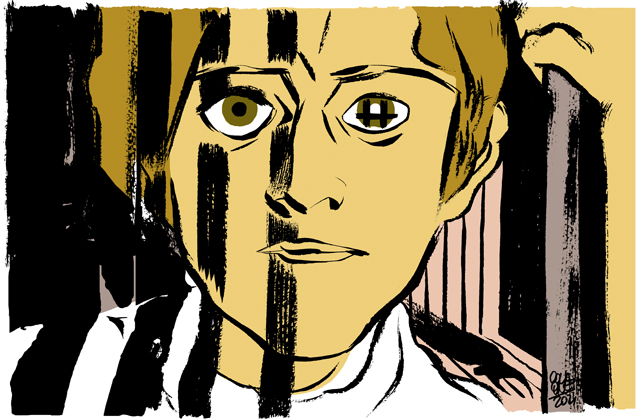Claustrophobic Visions of the Asylum: The Photobooks of the Italian Psychiatric Reform
Abstract
In this article, I compare the strategies of visual representation employed in the two 1969 photobooks Gli esclusi (D’Alessandro-Piro) and Morire di classe (Berengo Gardin et al.). These photobooks have been the photographic protagonists of the reform of psychiatric health care that, fed by the upheavals of the late 1960s, brought about the closure of psychiatric asylums in 1978 thanks to the famous Law 180. I will specifically focus on the representation of claustrophobic spaces in their relationship with the bodies of inmates compared to the traditional iconography of madness. This article aims to show that these photobooks (while employing radically different strategies of representation) aim at providing a visual translation of the pivotal philosophical coordinates that guided the reform of psychiatric health care.
Downloads
References
Barthes, Roland, Mythologies, New York, The Noonday Press, 1991.
Basaglia, Franco, “Il mondo dell’incomprensibile schizofrenico”, in Franco Basaglia, Scritti 1953–1980, Milano, il Saggiatore, 2017a [1953]: 47-70.
Id., “La ‘Comunità Terapeutica’ come base in un servizio psichiatrico: Realtà e prospettive”, in Franco Basaglia, Scritti 1953–1980, Milan, il Saggiatore, 2017b [1965]: 271-90.
Id., “La comunità terapeutica e le istituzioni psichiatriche”, in Franco Basaglia, Scritti 1953–1980, Milan, il Saggiatore, 2017c [1968]: 507-16.
Basaglia, Franco – Ongaro, Franca, “Introduzione a Morire di classe”, in Franco Basaglia, Scritti 1953–1980, Milan, il Saggiatore, 2017: 567-72.
Berengo Gardin, Gianni et al., Morire di classe. La condizione manicomiale fotografata, Torino, Einaudi, 1969.
Berengo Gardin, Gianni et al., “The Concerned Photographer: gruppo italiano”, Il diaframma: fotografia italiana, Maggio 1973, no page numbers.
Bordini, Silvia, Photobook. L’immagine di un’immagine, Milan, Postmedia Press, 2020.
Campany, David, Photography and Cinema, London, Reaktion Books, 2008.
Carrara, Giuseppe, Storie a vista. Retorica e poetiche del fototesto, Milano, Mimesis, 2020, Kindle Edition.
Cesareo, Giovanni, “Follia ed informazione nella stampa italiana”, in ed. Carlo Pirovano (a cura di), Inventario di una psichiatria, Milano, Electa: 29.
Curti, Denis, Gianni Berengo Gardin. Stories of a Photographer, Venice, Marsilio, 2013.
D’Alessandro, Luciano, “Il mondo degli esclusi”, Popular Photography Italiana, CXVII, 1967: 51-4.
D’Alessandro, Luciano ‒ Piro, Sergio, Gli esclusi. Fotoreportage da un’istituzione totale, Milano, Il Diaframma, 1969.
D’Autilia, Gabriele, Storia della fotografia in Italia: dal 1839 a oggi, Torino, Einaudi, 2012.
Forgacs, David, Italy’s Margins. Social Exclusion and Nation Formation since 1861, Cambridge, Cambridge University Press, 2014.
Foot, John, “Photography and Radical Psychiatry in Italy in the 1960s: The Case of the Photobook Morire di classe (1969)”, History of Psychiatry, 26.1, 2015: 19-35.
Giannichedda, Maria Grazia, “Introduzione”, in Franco Basaglia. L’utopia della realtà, Ed. Franca Ongaro Basaglia, Torino, Einaudi, 2005: vii-lii.
Goffman, Erving Asylums: Essays on the Condition of the Social Situation of Mental Patients and Other Inmates, New York, Anchor Books, 1961.
Grassi, “L’obiettivo penetra nel mondo degli ‘esclusi:’ Eccezionale inchiesta nella ‘fossa dei serpenti’”, Roma, March 11, 1969.
Manzoli, Federica, “La follia per immagini”, Journal of Science Communication, 3.2, 2004: 1-7.
Ongaro, Franca (ed.), Per non dimenticare. 1968. La realtà manicomiale di “Morire di classe”, Torino, Edizioni Gruppo Abele, 1998.
Orsi, Francesca, Il ritratto della follia: la fotografia psichiatrica in Italia dal 1850 al 2000, Tesi di laurea, Università La Sapienza di Roma, 2008.
Parr, Martin and Badger, Gerry, The Photobook: A History, Vol. 1, London and New York, Phaidon, 2004.
Piro, Sergio, “Fotografia e alienità”, Popular Photography Italiana, 117, 1967: 55 and 88.
Piro, Sergio, “Prefazione”, in Gli esclusi. Fotoreportage da un’istituzione totale, Milan, Il Diaframma, 1969: n.p.
Pitrelli, Nico, L’uomo che restituì la parola ai matti: Franco Basaglia, la comunicazione e la fine dei manicomi, Rome, Editori Riuniti, 2004.
Ripa, Cesare, Iconologia overo descrittione d’imagini delle virtù. Vitij, affetti, passioni humane, corpi celesti, mondo e sue parti, Venezia, Cristoforo Tomasini, 1645.
Russo, Antonella, Storia culturale della fotografia italiana: dal neorealismo al postmoderno, Torino, Einaudi, 2011.
Schinaia, Cosimo, “Fotografia e psichiatria”, Storia d’Italia. Annali 20: L’immagine fotografica 1945–2000, Ed. Uliano Lucas, Torino, Einaudi: 459-76.
Stefanile, Mario, “Un reportage fotografico di Luciano D’Alessandro”, Il Mattino, March 6, 1969.
Sforza Tarabochia, Alvise, “Photography, Psychiatry, and Impegno: Morire di classe (1969) between Neorealism and Postmodernism”, The Italianist, 36. 1,2018: 48-69.
Id., “Mental, Social, and Visual Alienation in D’Alessandro’s Photography”, in Alessandra Diazzi – Alvise Sforza Tarabochia (eds.), The Years of Alienation in Italy, London and New York, Palgrave Macmillan, 2019: 211-28.
Id., “The Staff of Madness: the Visualization of Insanity and the Othering of the Insane”, History of Psychiatry, 32.2,2021: 176-94.
Copyright Notice
You are free to copy, distribute and transmit the work, and to adapt the work. You must attribute the work in the manner specified by the author or licensor (but not in any way that suggests that they endorse you or your use of the work).









